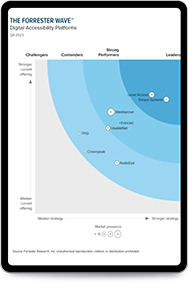Three Reasons to Start Prioritizing European Accessibility Act Compliance Now
Jun 13, 2024
As the regulatory landscape surrounding digital accessibility tightens in the U.S., with new requirements recently introduced under Title II of the Americans with Disabilities Act (ADA), rulemaking is just as active overseas. In June 2025, nations across the European Union (EU) will begin enforcing the European Accessibility Act, also known as the EU Accessibility Act or EAA, which mandates the accessibility of many consumer products and services—including digital experiences related to e-commerce and banking.

Importantly, the law applies to any organization that provides covered products and services to consumers in the EU, regardless of where that organization is based. So, if your organization conducts business or has customers in the EU, chances are that you’ll need to comply with the EAA. You can learn more about this law and your compliance obligations in our fact sheet.
Don’t have a plan yet for how to bring your digital portfolio into alignment with the law’s requirements? Here are three reasons to get started sooner rather than later.
1. Compliance involves more than fixing accessibility issues.
Often, organizations assume that compliance with digital accessibility laws starts and stops with a one-time audit, followed by the remediation of any issues identified in that audit. Once they’ve achieved conformance with technical digital accessibility standards, they believe their work is done.
In the case of the EU Accessibility Act, the presumed technical standard for compliance is EN 301 549. This European standard currently incorporates version 2.1 A and AA of the Web Content Accessibility Guidelines, or WCAG (it’s currently being updated to adopt WCAG 2.2) and includes additional requirements for hardware and mobile apps. But conforming with EN 301 549 accessibility standards is just one step toward meeting the law’s requirements.
Many national laws adopting the EAA mandate that organizations also implement processes that support a continuous accessibility program—such as regular reporting, ongoing monitoring, and training. These practices ultimately help organizations maintain the accessibility of their digital experiences over time, reducing the risk that updates introduce new barriers for users. And because establishing a sustainable program won’t happen overnight, it’s wise to get started now.
Learn how to prepare for the EAA from compliance experts
2. You may need to involve third-party vendors.
The EU Accessibility Act’s requirements apply to most digital technology from third-party vendors. So, if your digital experiences include third-party products or content (for example, a chatbot widget or payment processing integration purchased from a vendor), the EAA requires that those products are also accessible.
If a product from one of your current vendors is not accessible, you may need to procure the same product from a vendor that can validate product accessibility. By discussing accessibility with your current vendors sooner rather than later, you can ensure you have the time you need to act accordingly.
Additionally, to maintain EAA compliance, consider making accessibility a requirement for product procurement moving forward. When vetting new vendors, make sure to request a completed Voluntary Product Accessibility Template (VPAT) demonstrating conformance with EN 301 549. This will reduce your risk of unintentionally jeopardizing your compliance efforts by integrating new third-party technology that does not meet accessibility requirements.
3. Non-compliance with the EU Accessibility Act has consequences.
Neglecting to meet the EU Accessibility Act’s requirements by the enforcement deadline means taking significant financial and operational risks. Individual EU nations are required by the law to monitor compliance across the market, and non-compliant organizations may face penalties ranging from steep fines to the suspension of their right to do business. In fact, according to an Irish law adopting the EAA, non-compliant organizations may even face jail time!
There are also opportunity costs to inaccessibility. It’s estimated that one in four adults in the EU has a disability, and businesses that exclude this community significantly limit their consumer base. Given the consequences of non-compliance, getting—and staying—on track to meet the June 2025 deadline is essential to protecting your business.
Everything you need to know about EAA compliance and enforcement
Achieve EAA compliance with confidence.
Whether you’re new to digital accessibility or scaling an existing program, managing compliance with the EU Accessibility Act and other laws can feel complex. A trusted digital accessibility solution provider can help you clearly understand your obligations, and equip you with the tools, training, and guidance you need to meet them.
Level Access has over 25 years of experience supporting organizations of all sizes, from start-ups to global enterprises, to achieve their accessibility and compliance goals. Our experts will help you swiftly bring your digital portfolio into conformance with EN 301 549 and provide the tools and training necessary to satisfy the full range of EAA requirements. To get started, contact our team today.
Subscribe for updates

